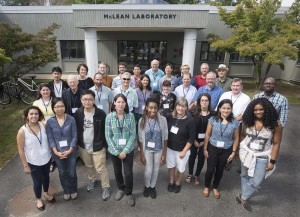Ramped pyrolysis/oxidation (RPO), known colloquially as “dirt burning”, involves ramped heating of sediment or soil samples to generate gases suitable for capture and radiocarbon analysis. RPO radiocarbon analysis has been used to discern 14C age spectra and carbon dynamics in sediments with a variety of organic carbon sources. A recent NSF-funded workshop on Thermal Analysis of Natural Organic Matter held Sept. 15-16, 2016 at the National Ocean Sciences Accelerator Mass Spectrometry (NOSAMS) facility at the Woods Hole Oceanographic Institute (WHOI) brought a variety of researchers together to explore other potential applications of RPO. A combination of oceanographers, soil scientists, biogeochemists, and biologists convened to discuss the technique, which has emerged out of its infancy and into a nebulous adolescence. The core objectives of the workshop included: 1) Facilitating discussion between those using and interested in RPO, 2) Discussing how current RPO applications have increased understanding of Earth systems, 3) Targeting technical improvements and methodological experiments, and 4) Defining issues that would benefit from development and application of RPO. Discussion centered on geoscience and technical questions. For biogeochemistry, future endeavors for RPO can focus on discerning soil age distributions, bioreactor kinetics, and analysis of old ocean (and potentially freshwater) DOC. Technical questions involved refining RPO’s assessment of 14C content more directly with 14C age. Attendees also questioned how RPO can help assess the effect of chemical treatment on sample analysis. The technique is of particular interest to my dissertation research. The Plante lab frequently uses ramped combustion for the characterization of soil organic matter. I intend to couple those methods with 14C analyses on a set of African Dark Earth samples to examine the stability of organic matter in these soils.
Categories
Recent Posts
- New postdoc opportunity – Feb 2024 deadline December 18, 2023
- My Experience as an Undergraduate Research Assistant in the Plante Lab May 25, 2021
- Research in the time of COVID February 25, 2021

Recent Comments